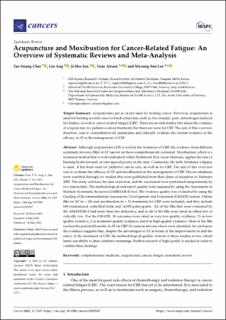| dc.contributor.author | Choi, Tae-Young | |
| dc.contributor.author | Ang, Lin | |
| dc.contributor.author | Jun, Ji Hee | |
| dc.contributor.author | Alræk, Terje | |
| dc.contributor.author | Lee, Myeong Soo | |
| dc.date.accessioned | 2022-11-11T08:16:01Z | |
| dc.date.available | 2022-11-11T08:16:01Z | |
| dc.date.created | 2022-09-07T14:56:47Z | |
| dc.date.issued | 2022 | |
| dc.identifier.citation | Cancers. 2022, 14 (10). | en_US |
| dc.identifier.issn | 2072-6694 | |
| dc.identifier.uri | https://hdl.handle.net/11250/3031312 | |
| dc.description.abstract | Although acupuncture (AT) is used in the treatment of CRF, the evidence from different systematic reviews (SRs) of AT has not yet been comprehensively evaluated. Moxibustion, which is a treatment method that is well established within Traditional East Asian Medicine, applies the heat of burning herbs towards or onto special points on the skin. Commonly, the herb Artemisia vulgaris, is used. It has been used for palliative cancer care, as well as for CRF. The aim of this overview was to evaluate the efficacy of AT and moxibustion in the management of CRF. Eleven databases were searched through for studies that were published from their dates of inception to February 2022. The study selection, the data extraction, and the assessment were performed independently by two researchers. The methodological and report quality were assessed by using the Assessment of Multiple Systematic Reviews-2 (AMSTAR-2) tool. The evidence quality was evaluated by using the Grading of Recommendations Assessment, Development and Evaluation (GRADE) system. Fifteen SRs on AT (n = 10) and moxibustion (n = 5) treatments for CRF were included, and they include 169 randomized controlled trials and 14,392 participants. All of the SRs that were evaluated by the AMASTAR-2 had more than one deficiency, and so all of the SRs were rated as either low or critically low. For the GRADE, 18 outcomes were rated as very-low-quality evidence, 13 as low-quality evidence, 3 as moderate-quality evidence, and 0 as high-quality evidence. Most of the SRs reached the potential benefits of AT for CRF. No serious adverse effects were identified. In conclusion, the evidence suggests that, despite the advantages of AT in terms of the improvement in and the safety of the treatment of CRF, the methodological quality of most of these studies is low, which limits our ability to draw definitive meanings. Further research of high quality is needed in order to confirm these findings. | en_US |
| dc.description.sponsorship | T.Y. Choi, L.A., J.H.J. and M.S.L. were supported by the Korea Institute of Oriental Medicine, Korea (KSN2021210). T.A. is the PI of an ongoing study that is funded by a grant from Pink Ribbon, which is a collaboration between The Norwegian Cancer Association and the Breast Cancer Society (Contract no.: 207697-2019). The funder had no role in the study design, the data collection and analysis, the decision to publish, or the preparation of the manuscript. | en_US |
| dc.language.iso | eng | en_US |
| dc.rights | Navngivelse 4.0 Internasjonal | * |
| dc.rights.uri | http://creativecommons.org/licenses/by/4.0/deed.no | * |
| dc.subject | complementary medicine | en_US |
| dc.subject | acupuncture | en_US |
| dc.subject | cancer | en_US |
| dc.subject | fatigue | en_US |
| dc.subject | systematic review | en_US |
| dc.title | Acupuncture and Moxibustion for Cancer-Related Fatigue: An Overview of Systematic Reviews and Meta-Analysis | en_US |
| dc.title.alternative | Acupuncture and Moxibustion for Cancer-Related Fatigue: An Overview of Systematic Reviews and Meta-Analysis | en_US |
| dc.type | Peer reviewed | en_US |
| dc.type | Journal article | en_US |
| dc.description.version | publishedVersion | en_US |
| dc.source.pagenumber | 14. | en_US |
| dc.source.volume | 14 | en_US |
| dc.source.journal | Cancers | en_US |
| dc.source.issue | 10 | en_US |
| dc.identifier.doi | 10.3390/cancers14102347 | |
| dc.identifier.cristin | 2049582 | |
| dc.source.articlenumber | 2347 | en_US |
| cristin.ispublished | true | |
| cristin.fulltext | original | |
| cristin.qualitycode | 1 | |

